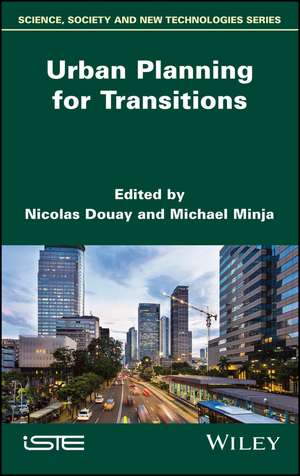Urban Planning for Transitions
Autor N Douayen Limba Engleză Hardback – 10 mai 2021
Urban planners have come up with transition proposals and concepts that they hope will be able to respond to cities challenges and ultimately allow them to adapt and make the transition into more robust urban areas. This book presents and discusses various urban transition strategies, action plans and programs that have been proposed or even conducted in different countries all over the world. Different countries require different strategies, but they all have the same goal in mind, each of them trying to address urban complexities and cope with the rapid pace at which the world is evolving.
Preț: 979.42 lei
Preț vechi: 1076.28 lei
-9% Nou
Puncte Express: 1469
Preț estimativ în valută:
187.44€ • 195.18$ • 158.41£
187.44€ • 195.18$ • 158.41£
Carte tipărită la comandă
Livrare economică 07-21 martie
Preluare comenzi: 021 569.72.76
Specificații
ISBN-13: 9781786306753
ISBN-10: 1786306751
Pagini: 224
Dimensiuni: 166 x 250 x 17 mm
Greutate: 0.49 kg
Editura: ISTE Ltd.
Locul publicării:Hoboken, United States
ISBN-10: 1786306751
Pagini: 224
Dimensiuni: 166 x 250 x 17 mm
Greutate: 0.49 kg
Editura: ISTE Ltd.
Locul publicării:Hoboken, United States
Cuprins
Introduction xi
Nicolas DOUAY and Michael MINJA
Chapter 1. Rotterdam Resilience Strategy, Rotterdam 1
Munir KHADER
1.1. Introduction 1
1.2. Context and background 1
1.3. Rotterdam Resilience Strategy - Ready for the 21st Century 3
1.3.1. Methodology 3
1.3.2. Rotterdam Resilience Strategy - Goals, stakeholders 5
1.3.3. Concrete resilient initiatives and programs 7
1.4. Conclusion 16
1.4. References 17
Chapter 2. Sustainable Florianópolis Action Plan, Santa Catarina 19
Flavia HOLLERWEGER
2.1. Introduction 19
2.2. Context: Florianopolis' background 20
2.3. The Sustainable Florianópolis Plan of Action 22
2.3.1. A comprehensive analysis of the city 22
2.3.2. Methodology 23
2.3.3. Goals and actions 24
2.4. Analysis - Discussion 29
2.5. Conclusion 31
2.6. References 32
Chapter 3. "Recife 500 Anos" Plan, Recife 33
Maria Carolina ARRUDA
3.1. Introduction 33
3.2. Strategy, transition and innovation in a contrasting urban scenario 33
3.2.1. Recife: Brazil's "capital of inequalities" 34
3.2.2. From an economic-oriented urbanism to a participatory strategic plan 36
3.3. The plan 37
3.3.1. A multi-institutional board 38
3.3.2. Research, public consultation and comparative analysis 39
3.3.3. Crossing strategies for integrated results 40
3.4. Critical analysis of the plan construction 43
3.5. Conclusion 45
3.6. References 46
Chapter 4. Greenest City 2020, Vancouver 47
Hala RAHOUI
4.1. Introduction 47
4.2. Context 48
4.3. Greenest City 2020 Action Plan - targets and goals 52
4.3.1. GCAP goals 53
4.3.2. Implementation updates 63
4.4. Why is the GCAP an innovative urban strategy? 65
4.5. Criticisms 65
4.6. Conclusion 66
4.7. References 66
Chapter 5. The Grandeur Nature Plan, Eurométropole of Strasbourg 69
Luc VOELKEL
5.1. Introduction 69
5.2. The Grandeur nature plan of the Eurométropole of Strasbourg 70
5.2.1. The stakeholders involved in the implementation of the plan 70
5.3. The content of the plan 73
5.4. The role of the Grandeur nature program 80
5.5. Conclusion 83
5.6. References 84
Chapter 6. The Car-free Livability Programme, Oslo 87
Michael MINJA
6.1. Introduction 87
6.2. Background: the Car-free Livability Programme of Oslo 88
6.3. The role of the Car-free Livability Programme and specific developments brought by it 91
6.3.1. Advocating city life at the expense of parking space 91
6.3.2. Exploratory urban development projects 92
6.3.3. New pedestrian streets and pedestrian-friendly urban spaces 93
6.3.4. The city center planning model for the future streets 95
6.4. Car-free city centers are not utopian models anymore 96
6.5. Conclusion 99
6.6. References 100
Chapter 7. A Carbon-free City, Uppsala 103
Bérénice JOURNET
7.1. Introduction 103
7.2. Context 104
7.3. The environmental program of Uppsala's municipality 107
7.3.1. Ambitions 107
7.3.2. Mobility 108
7.3.3. Green spaces as social areas 112
7.3.4. Fossil fuel free 114
7.4. An ambitious and inclusive environmental program: between ambitions and social realities 116
7.5. Conclusion 118
7.6. References 119
Chapter 8. The Bicycle Strategy 2011-2025, Copenhagen 121
Esraa ELESAWY
8.1. Introduction 121
8.2. Context 122
8.3. The bicycle city plan: making the city more livable by promoting cycling 124
8.3.1. SAFE from A to B 126
8.3.2. QUICK from A to B by 2025 127
8.3.3. COMFORT from A to B by 2025 129
8.3.4. CITY LIFE from A to B by 2025 131
8.4. BEST Copenhagen by 2025, BUT! 132
8.5. Conclusion 135
8.6. References 136
Chapter 9. Smart and Digital City Action Plan, Montreal 139
Daniel Carl NUNOO
9.1. Introduction 139
9.2. Context of Montreal 140
9.3. Montreal's smart and digital city action plan 142
9.3.1. Overview of strategy 142
9.3.2. Objectives and aims of the strategy 143
9.3.3. Implementation of the Montreal smart and digital city action plan 143
9.3.4. Results of the Montreal smart and digital city action plan in today's context 147
9.4. Analysis - discussion 149
9.5. Conclusion 151
9.6. References 151
Chapter 10. A Smart City Masterplan, Kigali 153
Haley BURNS
10.1. Introduction 153
10.2. Kigali background 154
10.3. Content of the plan 158
10.4. Analysis: Kigali for sale? 162
10.5. Conclusion 167
10.6. References 167
Chapter 11. The Array of Things, Chicago 171
Leonardo RICAURTE
11.1. Introduction 171
11.2. The Array of Things, city of Chicago 172
11.3. The project's strategy 172
11.3.1. Development and implementation of the project 172
11.3.2. Stakeholders 173
11.3.3. The technology behind 175
11.3.4. Further possibilities 177
11.4. A new way of perceiving the city 178
11.5. Conclusion 180
11.6. References 180
Chapter 12. 22@Barcelona Project, Barcelona 183
Jassmin ALI
12.1. Introduction 183
12.2. 22@Barcelona project case study 183
12.3. Content of the plan 185
12.3.1. Stakeholders 185
12.3.2. Content of the plan 187
12.4. Analysis: A transformed Poblenou 189
12.5. Conclusion 192
12.6. References 193
List of Authors 195
Index 197
